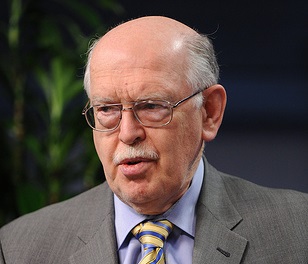HarvestPlus is pleased to cross-post this article written for the World Food prize blog, The Borlaug Blog, by Dr. Peter McPherson. Dr. McPherson is HarvestPlus' Program Advisory Committee Chair and is currently serving as President of the Association of Public and Land-Grant Universities.
The world is facing a well-known food and nutrition crisis. Even as millions of Americans lack access to healthy and nutritious food, 133 billion pounds of food is thrown away in the U.S. each year. Nearly 800 million people are currently undernourished globally and the world’s population is forecast to surge by 2.5 billion people by 2050. And the challenge is growing more urgent by the day. South Sudan is in the grip of famine. Nigeria, Somalia and Yemen are all on the brink of one. The food and nutrition challenges before us are as diverse as they are urgent, but we can tackle them with a holistic strategy and broad coalition.
That requires answering a dizzying array of questions. How can we increase crop yields, profitability, and environmental sustainability all at once? How can we develop the new seed varieties and animal breeds necessary for sustainable food systems? How can we reduce food loss and waste by developing more efficient distribution systems? How can we create and share resources that serve all populations? How can we ensure inclusive and equitable food systems? How can we address the dual burdens of undernutrition and obesity? And how can we ensure a safe and secure food supply that protects and improves human health?
These questions are what led to the Association of Public and Land-grant Universities’ Challenge of Change Commission, which recently released a report focused on public research universities’ role in helping achieve global food and nutrition security. The report outlines seven challenges for public research universities as they play a central role in addressing them.
Public research universities are the only place where leading scholars in all needed disciplines come together to pursue discoveries in their respective fields of study. Public universities have unlocked some of the greatest gains in nutrition, food security and environmental sustainability – both seeding and standing on the shoulders of Dr. Norman Borlaug’s work. But universities must more broadly use a research model that fosters collaborative research across disciplines, institutions and even borders. We have to nurture research that transcends disciplines. And we must educate society’s next generation of leaders to consider challenges not through the narrow prism of a given subject, but as they exist in the world – big, complex, inextricably intertwined.
Fortunately, many public research universities are already taking steps to do exactly that. Take work currently being undertaken at the University of Illinois and University of California, Berkeley. If we’re to achieve food and nutrition security, we have to vastly increase the efficiency of photosynthesis – the process plants use to convert light and carbon dioxide into oxygen and sugars they can then use for energy. Photosynthesis is the most fundamental building block of our food pyramid. Increasing its efficiency holds the potential to transform our food system and, crucially, reduce climate-changing greenhouse gases at the same time. Researchers at the University of Illinois and the University of California, Berkeley are examining plants which are most efficient at photosynthesis to apply those insights to other plants via genetic manipulation. Recent discoveries have led to 15 to 20 percent increases in photosynthesis for some plants. Now, we must achieve similar gains in food-related crops.
Yet the challenges reach far beyond just increasing food production. For decades, many have applied a laser-like focus on boosting crop yields without taking environmental consequences into account. But omitting environmental impacts hampers our ability to sustain, much less expand, food production and availability over time. Slash and burn agriculture, for instance, has bankrupted some of the world’s most ecologically rich forests while yielding farmland of dubious value. We need a comprehensive approach that safeguards the sustainability of our efforts.
That isn’t possible without clear, comprehensive and consistent leadership from the U.S. government. Working alongside public and private sector partners, the federal government can help make extraordinary improvements to global food systems. But like universities, the federal government is compartmentalized across subject areas. We need a whole-of-government strategy to enhance our food systems by codifying and harmonizing departments in service of our shared aim to vastly improve on our current trajectory. And we must redouble our commitment to programs like the World Food Programme, which play an absolutely indispensable role in understanding and addressing the food and nutrition challenges we face.
Public research universities can and must lead in the global effort to achieve food and nutrition security. Dr. Borlaug’s singular contributions to food and nutrition security sowed the seeds of the Green Revolution, freeing a billion people from the grip of famine. The food and nutrition challenges of the 21st century encompass a broader set of issues, but so does the coalition assembled to solve them. Working together, we have the ability to end the scourge of hunger and ensure food and nutrition security for all.
